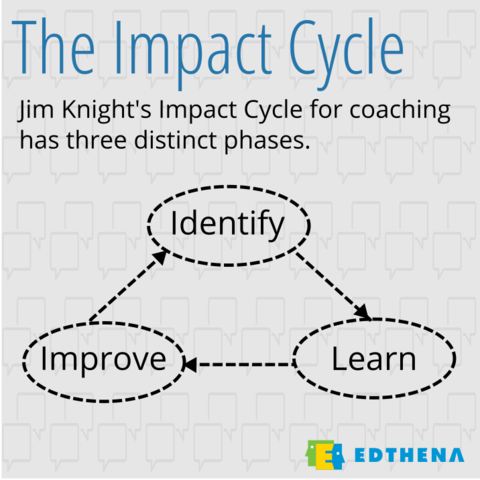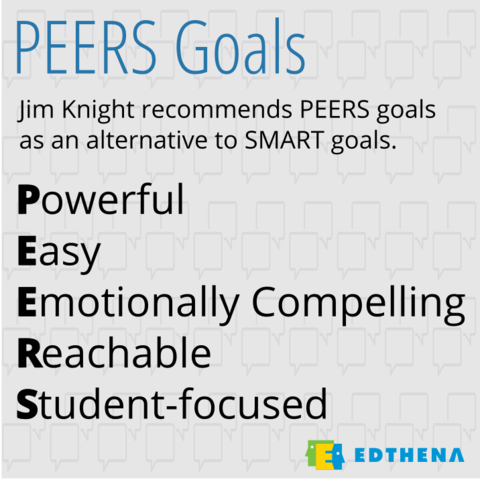Jim Knight Explains the Impact Cycle & PEERS Goals
According to Jim Knight, author of The Impact Cycle, “video is the most powerful tool for professional development… except for maybe the computer and the internet.” But why? And how does this structure called the Impact Cycle help to make it so effective?
One reason is that video offers teachers a “clear picture of current reality.” According to Knight, other attempts to provide teachers with feedback fail in this regard. As a result, educators are surprised to see the reality of their instruction when presented with video evidence.
Jim Knight presented alongside Adam Geller, author of Evidence of Practice, at the Learning Forward Annual Conference in Orlando, Fla., last fall. During his talk, Knight explained:
- The impact of video on instructional coaching
- Video’s place within the Impact Cycle
- The way that video transforms teacher goal-setting
Moving from a culture of talk to a culture of action
Knight notes that video has the power to move education from “a culture of talk to a culture of action.” According to Jim Knight, schools are prone to accept the status quo, and discuss changes but never actually implement them. Video changes this by delivering the “clear picture of current reality” to discuss.
“When you push the red button you’re gonna do something,” Knight says. In other words, teachers can’t deny the areas for improvement when they see them on video. It spurs them to take action and make change.
Equally as powerful is the way that video transforms the relationship between teacher and instructional coach. No longer is the coach responsible for telling the teacher what happened. Instead, the video shows it. The coach is there to discuss the results and offer support.
Knight sees video as transformational for professional development, akin to how Napster and iTunes revolutionized music. Further, video for PD is a new technology. There are still under-explored possibilities, such as video libraries of best teaching practices.
What are the steps of the Impact Cycle?

For instructional coaches looking to use video, Jim Knight offers his Impact Cycle framework. The framework first uses video to identify student-centered goals for teachers to meet. Later, video aids in measuring progress towards achieving these clear professional goals.
The impact cycle has three phrases: identify, learn, improve.
Video plays an important role in the identify phase. Teacher and coach view a video lesson using questions and checklists as guides. Together, the teacher and coach set a goal, known as a PEERS goal (see next section). This becomes the focus through the rest of the impact cycle.
In the learning phase, the coach helps the teacher with a strategy to help meet the goal. This might include modeling or showing teachers a video of a strategy in action.
Last comes the improvement phase. Knight notes that teachers rarely hit goals immediately. Instead, teachers and coaches often re-evaluate goals and determine whether or not they need to make changes.
Video is crucial in the improvement phase, allowing teacher and coach to revisit “current reality.” With visual evidence, it is easier to determine how the teacher has grown.
Fostering teacher buy-in with PEERS Goals
In order to create meaningful goals during coaching sessions, Knight suggests teachers and instructional coaches discuss these questions:
- On a scale of 1-10, how close is the lesson to your ideal?
- What pleased you about the lesson?
- How would you have changed it to make it closer to a 10?
- What would you see your students doing differently?
- Describe what that would look like.
- How could we measure that?
- Should that be your goal?
- If you could reach that goal would it really matter to you?
- What teaching strategy would you like to try to achieve your goal?
The discussion resulting from these questions helps coaches and teachers reliably create PEERS goals. This style of goal bears some resemblance to the popular SMART goal, but it contains a few specifics that make it especially relevant and useful for the instructional coach/teacher relationship.

PEERS goals are:
- Powerful – Teachers should select a goal that, if achieved, will make a real difference in students’ lives.
- Easy – In this case, “easy” does not mean the goal can be achieved with little effort. Instead, it means the goal is simple instead of unnecessarily complex.
- Emotionally-compelling – The teacher should care deeply about the goal. Video helps here. When teachers identify areas of instruction needing improvement, they are more likely to select personally meaningful goals.
- Reachable – This implies the goal can be measured, and the goal can be reached using a specific instructional strategy.
- Student-focused – A focus on students ensures reaching goals will result in improved learning outcomes for students. Teacher-focused goals may sound nice but may not be directly connected to student learning. For example, a teacher might set a goal to “integrate more technology into instruction.” It’s difficult, though, to know if the goal actually helped students learn more.
An example PEERS goal might be get 85% of the class authentically engaged using an instructional strategy of encouraging higher-level questioning.
By discussing lesson videos in a structured way, teachers see the “clear picture of current reality.” This compels them to set meaningful goals to improve student learning.



